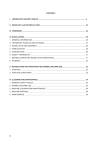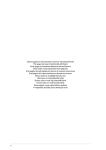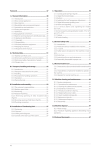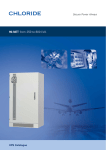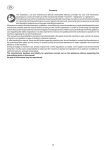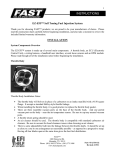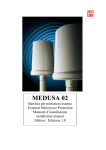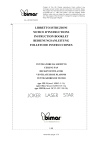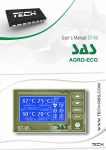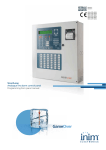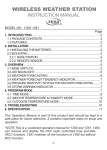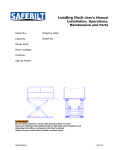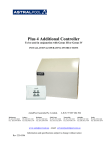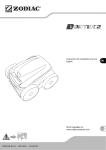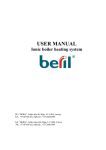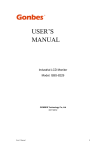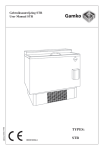Download User Manual - SharePoint
Transcript
EN Foreword The installation, use and maintenance Manual (hereinafter Manual) provides the user with information necessary for correct and safe use of the machine (hereinafter “machine”, “refrigerated/freezer base” or “appliance”). The following must not be considered a long and exacting list of warnings, but rather a set of instructions suitable for improving machine performance in every respect and, above all, preventing injury to persons and animals and damage to property due to improper operating procedures. All persons involved in machine transport, installation, commissioning, use and maintenance, repair and disassembly must consult and carefully read this manual before carrying out the various operations, in order to avoid wrong and improper actions that could compromise the machine’s integrity or endanger persons. Make sure to periodically inform the appliance user regarding the safety regulations. It is also important to instruct and update personnel authorised to operate on the machine, regarding its use and maintenance. The manual must be available to operators and carefully kept in the place where the machine is used, so that it is always at hand for consultation in case of doubts or whenever required. If, after reading this manual, there are still doubts regarding machine use, do not hesitate to contact the Manufacturer or the authorised after-sales service centre, to receive prompt and precise assistance for better operation and maximum efficiency of the machine. During all stages of machine use, always respect the current regulations on safety, work hygiene and environmental protection. It is the user’s responsibility to make sure the machine is started and operated only in optimum conditions of safety for persons, animals and property. The manufacturer declines any liability for operations carried out on the appliance without respecting the instructions given in this manual. No part of this manual may be reproduced. 29 Safety device a device (other than a guard) that eliminates or reduces the risk; it can be used alone or in combination with a guard. A.1 GENERAL INFORMATION A.1.1 INTRODUCTION Given below is some information regarding the machine’s intended use, its testing, and a description of the symbols used (that identify the type of warning), the definitions of terms used in the manual and useful information for the appliance user. Customer the person who purchased the machine and/or who manages and uses it (e.g. company, entrepreneur, firm). Electrocution an accidental discharge of electric current on a human body. A.1.2 INTENDED USE AND RESTRICTIONS Our appliances are designed and optimised in order to obtain high performance and efficiency. This appliance is designed for the refrigeration and preservation of foods. Any other use is deemed improper. The appliance must not be used by people (including children) with limited physical, sensory or mental abilities or without experience and knowledge of it, unless instructed in its use by those responsible for their safety. ATTENTION: The appliance is not suitable for installation outdoors and/or in places exposed to atmospheric agents (rain, direct sunlight, etc.). The manufacturer declines any liability for improper use of the product. A.1.5 TYPOGRAPHICAL CONVENTIONS For best use of the manual, and therefore the machine, it is advisable to have good knowledge of the terms and typographical conventions used in the documentation. The following symbols are used in the manual to indicate and identify the various types of hazards: ATTENTION! DANGER FOR THE HEALTH AND SAFETY OF OPERATORS. ATTENTION! DANGER OF ELECTROCUTION DANGEROUS VOLTAGE. A.1.3 TESTING AND INSPECTION Our appliances are designed and optimised, with laboratory testing, in order to obtain high performance and efficiency. The product is shipped ready for use. The certificates guaranteeing that the tests (visual inspection electrical test - functional test) have been passed are included in specific enclosures. ATTENTION! RISK OF DAMAGE TO THE MACHINE. Words further explaining the type of hazard are placed next to the symbols in the text. The warnings are intended to guarantee the safety of personnel and prevent damage to the machine or the product being worked. The drawings and diagrams given in the manual are not in scale. They supplement the written information with an outline, but are not intended to be a detailed representation of the machine supplied. The numerical values given on the machine installation diagrams refer to measurements expressed in mm. A.1.4 DEFINITIONS Listed below are the definitions of the main terms used in the manual. Carefully read them before using the manual. Operator machine installation, adjustment, use, maintenance, cleaning, repair and transport personnel. Manufacturer Electrolux Professional SPA or any other service centre authorised by Electrolux Professional SPA. A.1.6 MACHINE AND MANUFACTURER’S IDENTIFICATION DATA A reproduction of the marking or dataplate on the machine is given below: Operator for normal machine use an operator who has been informed and trained regarding the tasks and hazards involved in normal machine use. F.Mod. COMP36R PNC 9VTX 727188 00 W Tot. 0.57 kW Technical assistance or specialised technician an operator instructed/trained by the Manufacturer and who, based on his professional and specific training, experience and knowledge of the accident-prevention regulations, is able to appraise the operations to be carried out on the machine and recognise and prevent any risks. His professionalism covers the mechanical, electrotechnical and electronics fields. Comm.Model COMP36R Ser.Nr. 02807001 Volt 230V 1N ~ 50Hz Potenza Sbrinamento / Defrost Power 0.15 kW Cyclopentane 2010 Total Current 3.2 A Classe / Class 5 Resistenza Evaporazione / Evaporation Heater El. 0 kW Refrigerante / Refrigerant R404a 0,13 Kg Illuminazione / Lighting Cap. 0 0W NF nominal Charge Rated Pressure Mpa IP23 Electrolux Professional SPA - Viale Treviso, 15 - 33170 Pordenone (Italy) Danger source of possible injury or harm to health. The dataplate gives the product identification and technical data. Hazardous situation any situation where an operator is exposed to one or more hazards. Risk a combination of probabilities and risks of injury or harm to health in a hazardous situation. Guards safety measures consisting of the use of specific technical means (guards and safety devices) for protecting operators against dangers. Guard an element of a machine used in a specific way to provide protection by means of a physical barrier. 30 The Manufacturer declines any liability for damage caused by arbitrary modifications and conversions carried out by the user or the Customer. The employer, workplace manager or service technician are responsible for identifying and choosing adequate and suitable personal protection equipment to be worn by operators, in compliance with regulations in force in the country of use. Electrolux Professional SPA declines any liability for any inaccuracies contained in the manual, if due to printing or translation errors. Any supplements to the installation, use and maintenance manual the Customer receives from the Manufacturer will form an integral part of the manual and therefore must be kept together with it. The meaning of the various information given on it is listed below: F.Mod. ……………………………factory description of product Comm.Model …………………… trade description PNC ………………………………production number code Ser.No. ……………………………serial number 230V 1N ………………………… power supply voltage 50 Hz …………………………… power supply frequency 0.57 kW ………………………… max. power input Cyclopentane……………….....…expanding gas used in insulation Total Current……………….…… current absorbed Defrost Power …….………….... defrost power Evaporation Heater El.………… heating element power Lighting…………….………......... internal light power Class……………………………. climatic class Refrigerant………………..…….. type of refrigerant gas Cap………………………………. nominal capacity IP23 ………………………………dust and water protection rating CE …………………………………CE marking Electrolux Professional SPA Viale Treviso, 15 33170 Pordenone (Italy)………………………………Manufacturer A.1.10 PERSONAL PROTECTION EQUIPMENT Give below is a summary table of the Personal Protection Equipment (PPE) to be used during the various stages of the machine’s service life. Protective Safety garments footwear Gloves Glasses Ear protectors Mask Safety helmet Stage Transport Handling Unpacking Assembly When installing the appliance, make sure the electrical connection is carried out in compliance with that specified on the dataplate. Normal use X Adjustments Routine cleaning Extraordinary cleaning ATTENTION! Do not remove, tamper with or make the machine “CE” marking illegible. Maintenance Dismantling Scrapping ATTENTION! Refer to the data given on the machine “CE” marking for relations with the Manufacturer (e.g. when ordering spare parts, etc.). Key: X X X X X X X X X X X X X (*) X (*) X PPE REQUIRED PPE AVAILABLE OR TO BE USED IF NECESSARY ATTENTION! When scrapping the machine, the “CE” marking must be destroyed. PPE NOT REQUIRED A.1.7 APPLIANCE IDENTIFICATION This manual applies to various refrigerated/freezer base models. For further details regarding your model, refer to the section A.2.2 DIMENSIONS, PERFORMANCE AND CONSUMPTION. (*) During Normal use, gloves protect hands from the cold tray when being removed from the appliance. A.1.8 COPYRIGHT This manual is intended solely for consultation by the operator and can only be given to third parties with the permission of Electrolux Professional SPA. Failure to use the personal protection equipment by operators, specialised technicians or users can involve exposure to chemical risk and possible damage to health. NOTE: The gloves to be worn during Cleaning are the type suitable for contact with the cooling fins (metal plates). A.1.11 KEEPING THE MANUAL The manual must be carefully kept for the entire life of the machine, until scrapping. The manual must stay with the machine in case of transfer, sale, hire, granting of use or leasing. A.1.9 RESPONSIBILITY The Manufacturer declines any liability for damage and malfunctioning caused by: • non-compliance with the instructions contained in this manual; • repairs not carried out in a workmanlike fashion, and replacements with parts different from those specified in the spare parts catalogue (the fitting and use of non-original spare parts and accessories can negatively affect machine operation and invalidates the warranty); • operations by non-specialised technicians; • unauthorised modifications or operations; • inadequate maintenance; • improper machine use; • unforeseeable extraordinary events; • use of the machine by uninformed and untrained personnel; • non-application of the current provisions in the country of use, concerning safety, hygiene and health in the workplace. A.1.12 RECIPIENTS OF THE MANUAL This manual is intended for: • the carrier and handling personnel; • installation and commissioning personnel; • the employer of machine users and the workplace manager; • operators for normal machine use; • specialised technicians - after-sales service (see service manual). 31 “N900” refrigerated/freezer base Operating mode Ventilated Power supply 230V single-phase 50Hz Absorbed current 4.5 A Absorbed power 760 W Refrigerant type R404A Qty refrigerant 180 g No. and type of defrosts in 24 h 3xmax 25 minutes - electric Max. absorbed power in defrost 380 W Working temperature (from/to) -22°C/+8°C Protection rating IPX3 Equivalent sound pressure level Leq (¹) dB(A) <70 A.2 TECHNICAL DATA The areas in contact with the product are in steel or coated with non-toxic plastic material. An HFC refrigerant fluid complying with the current regulations is used in the refrigerating units. The type of refrigerant gas used is given on the dataplate. A.2.2 DIMENSIONS, PERFORMANCE AND CONSUMPTION 2 drawer refrigerated/freezer base 36" Operating mode Ventilated Power supply 230V single-phase 50Hz Absorbed current 3.2 A Absorbed power 670 W Refrigerant type R404A Qty refrigerant 130 g No. and type of defrosts in 24 h 3xmax 25 minutes - electric Max. absorbed power in defrost 270 W Working temperature (from/to) -22°C/+8°C Protection rating IPX3 Equivalent sound pressure level Leq (¹) dB(A) <70 (¹) The value could increase depending on the work station where measured. A.2.3 MECHANICAL SAFETY CHARACTERISTICS, HAZARDS The appliance does not have sharp edges or protruding parts. The guards for the movable and live parts are fixed to the cabinet with screws to prevent accidental access. A.2.4 CLIMATIC CLASS The climatic class given on the dataplate refers to the following values: (¹) The value could increase depending on the work station where measured. 2 drawer refrigerated/freezer base 48" Operating mode Ventilated Power supply 230V single-phase 50Hz Absorbed current 4.5 A Absorbed power 760 W Refrigerant type R404A Qty refrigerant 180 g No. and type of defrosts in 24 h 3xmax 25 minutes - electric Max. absorbed power in defrost 380 W Working temperature (from/to) -22°C/+8°C Protection rating IPX3 Equivalent sound pressure level Leq (¹) dB(A) <70 • for refrigerated and freezer models CLIMATIC CLASS: 5 43°C (EN 60335-2-89) 40°C room with 40% relative humidity (EN ISO 23953). B.1 TRANSPORT, HANDLING AND STORAGE B.1.1 INTRODUCTION Transport (i.e. transfer of the machine from one place to another) and handling (i.e. transfer inside workplaces) must occur with the use of special and adequate means. (¹) The value could increase depending on the work station where measured. ATTENTION! Due to their size, the machines cannot be stacked on top of each other during transport, handling and storage; this eliminates any risks of loads tipping over due to stacking. 4 drawer refrigerated/freezer base 72" Operating mode Ventilated Power supply 230V single-phase 50Hz Absorbed current 7.1 A Absorbed power 1260 W Refrigerant type R404A Qty refrigerant 180 g+130 g No. and types of defrosts in 24 h 3xmax 25 minutes - electric Max. absorbed power in defrost 530 W Working temperature (from/to) -22°C/+8°C Protection rating IPX3 Equivalent sound pressure level Leq (¹) dB(A) <70 The machine must only be transported, handled and stored by qualified personnel, who must: - have specific technical training and experience in the use of lifting systems; - have knowledge of the safety regulations and applicable laws in the relevant sector; - have knowledge of the general safety rules; - ensure the use of personal protection equipment suitable for the type of operation carried out; - be able to recognise and avoid any possible hazard. (¹) The value could increase depending on the work station where measured. B.1.2 TRANSPORT: INSTRUCTIONS FOR THE CARRIER ATTENTION! Do not stand under suspended loads during loading/ unloading operations. Unauthorised personnel must not enter the work area. 4 drawer refrigerated/freezer base 84" Operating mode Ventilated Power supply 230V single-phase 50Hz Absorbed current 7.8 A Absorbed power 1290 W Refrigerant type R404A Qty refrigerant 2x180 g No. and types of defrosts in 24 h 3xmax 25 minutes - electric Max. absorbed power in defrost 615 W Working temperature (from/to) -22°C/+8°C Protection rating IPX3 Equivalent sound pressure level Leq (¹) dB(A) <70 ATTENTION! The machine’s weight alone is not sufficient to keep it steady. The transported load can shift: - when braking; - when accelerating; - in corners; - on particularly rough roads. B.1.3 HANDLING Arrange a suitable area with flat floor for machine unloading and storage operations. (¹) The value could increase depending on the work station where measured. 32 B.1.4 PROCEDURES FOR HANDLING OPERATIONS For correct and safe lifting operations: • use the type of equipment most suitable for characteristics and capacity (e.g. electric pallet truck or lift truck); • cover sharp edges; B.2 INSTALLATION AND ASSEMBLY To ensure correct operation of the appliance and maintain safe conditions during use, carefully follow the instructions given below in this section. Before lifting: • send all operators to a safe position and prevent persons from entering the handling area; • make sure the load is stable; • make sure no material can fall during lifting. Manoeuvre vertically in order to avoid impacts; • handle the machine, keeping it at minimum height from the ground. ATTENTION! The operations described below must be carried out in compliance with the current safety regulations, regarding the equipment used and the operating procedures. ATTENTION! Before moving the appliance make sure the load bearing capacity of the lifting equipment to be used is suitable for its weight. ATTENTION! For machine lifting, do not use movable or weak parts such as: casings, electrical raceways, pneumatic parts, etc. B.2.1 THE CUSTOMER’S RESPONSIBILITIES The Customer must: - arrange a point of connection to the power supply with earth and of suitable capacity for the input specified on the data plate; for information regarding the electrical connection, refer to par. B.2.5 “Electrical connection”; - check the flatness of the surface on which the machine is placed. B.1.5 TRANSLATION The operator must: • have a general view of the path to be followed; • stop the manoeuvre in case of hazardous situations. ATTENTION! Do not push or pull the appliance to move it, as it may tip over. B.2.2 MACHINE SPACE LIMITS A suitable space must be left around the machine (for operations, maintenance, etc.). This space must be increased in case of use and/or transfer of other equipment and/or means or if exit routes are necessary inside the workplace. Make sure to position the appliance at least 50 mm from any other machines present in the room (in fact, close proximity can create problems of condensation forming on the walls of the appliances), also taking into consideration the space needed for drawer opening. B.1.6 PLACING THE LOAD Before placing the load, make sure the way is free and that the floor is flat and can take the load. Use a fork-lift truck to move the appliance; inserting the forks under the pallet, lift the appliance making sure the load is balanced. B.1.7 STORAGE The machine and/or its parts must be stored and protected against damp, in a non-aggressive place free of vibrations and with room temperature between -10°C and +50°C. The place where the machine is stored must have a flat support surface in order to avoid any twisting of the machine or damage to the support feet. B.2.3 POSITIONING ATTENTION! Appliance installation must only be carried out by the manufacturer’s service personnel or by a skilled person. ATTENTION! Machine positioning, installation and disassembly must be carried out by a specialised technician. Install the appliance, taking all the safety precautions required for this type of operation, also respecting the relevant fireprevention instructions. Install the appliance in a ventilated place, away from heat sources such as radiators or air conditioning systems, to allow correct cooling of the refrigerating unit components. To avoid compromising correct appliance operation, never cover the front panel slits, even temporarily. If the appliance is installed in a place where there are corrosive substances (chlorine, etc.), it is advisable to go over all the stainless steel surfaces with a rag moistened with paraffin oil in order to create a protective film. Adjust the height and levelling with the adjustment feet, also checking correct drawer closing. ATTENTION! Do not make modifications to the parts supplied with the machine. Any missing or faulty parts must be replaced with original parts. The machine must be taken to the place of installation and the packing base removed only when being installed. Arranging the machine: • position the machine in the required place; • adjust the height and levelling with the adjustment feet, also checking correct drawer closing. ATTENTION! The appliance must be levelled; otherwise its operation could be affected. ATTENTION! Appliances with wheels can be moved for distances shorter than the length of the power supply connection cable; for longer distances, the appliance must be electrically disconnected. 33 If the power cable is damaged, it must be replaced by the after-sales service or in any case by qualified personnel, in order prevent any risk. • Wear protective gloves and unpack the machine, carrying out the following operations: - cut the straps and remove the protective film, taking care not to scratch the surface if scissors or blades are used; - remove the cardboard top, the polystyrene corners and the vertical protection pieces. For appliances with stainless steel cabinet, remove the protective film very slowly without tearing it, to avoid leaving glue stuck to the surface. Should this happen, remove the traces of glue with a non-corrosive solvent, rinsing it off and drying thoroughly; it is advisable to go over all the stainless steel surfaces with a rag soaked in paraffin oil in order to create a protective film. The manufacturer declines any liability for damage or injury resulting from breach of the above rules or non-compliance with the electrical safety regulations in force in the country where the appliance is used. ATTENTION: An H07RN-F power cable (designation 60245 IEC 66) is used for the permanent connection to the power supply; when replacing it, use a type having at least these characteristics. B.2.4 DISPOSAL OF PACKING The packing must be disposed of in compliance with the current regulations in the country where the appliance is used. All the packing materials are environmentally friendly. They can be safely kept, recycled or burnt in an appropriate waste incineration plant. Recyclable plastic parts are marked as follows: polyethylene: PE ATTENTION: When replacing the cable, the earth wire must be kept longer than the live and neutral wires. C.1 OPERATION C.1.1 ACCESSING THE CONTROL PANEL To access the control panel, proceed as follows: outer wrapping, instruction booklet bag polypropylene: straps polystyrene foam: corner protectors • undo the 2 screws located on the front panel: using a screwdriver, turn the screw until hearing a click: PP PS The parts in wood and cardboard can be disposed of, respecting the current regulations in the country where the machine is used. The appliance uses a single-phase 230V/50Hz power supply. The factory-set inside temperature is +0°C; the room temperature where the appliance is installed must not exceed 43°C, in order to maintain the required inside temperatures. B.2.5 ELECTRICAL CONNECTION Connection to the power supply must be carried out in compliance with the regulations and provisions in force in the country of use. • carefully open the upper part of the front panel as shown in the drawing (pay attention because it is fitted in the lower part): ATTENTION! Work on the electrical systems must only be carried out by a qualified electrician. The information regarding the appliance power supply voltage is given on the dataplate. Before connecting, make sure: - the connection point has an efficient earth contact and the mains voltage and frequency match that given on the data plate. In case of doubts regarding the efficiency of the earth wire, have the system checked by qualified personnel; - the system power supply is arranged and able to take the actual current absorption and that it is correctly executed according to the regulations in force in the country of use; - the appliance must be permanently connected to the power supply, respecting the polarities: - brown: phase - yellow/green: earth - blue: neutral; - a differential thermal-magnetic switch suitable for the input specified on the dataplate, with contact gap enabling complete disconnection in category III overvoltage conditions and complying with the regulations in force, is installed between the power cable and the electric line. For the correct size of the switch, refer to the absorbed current specified on the appliance dataplate. The chosen device must be lockable in the open position in case of maintenance. • After making the connection, with the appliance running check that the power supply does not fluctuate by ±10% the rated voltage. • lift the panel upwards, removing it from its position: 34 C.1.4.1 LEDs • the control panel can now be accessed: LED MODE FUNCTION On Compressor working Flashing Anti-short cycle delay activated On Fan working On Defrost activated On Fast freezing function activated On Alarm signal C.1.2 DESCRIPTION OF KEYS 1 2 4 6 7 9 11 C.1.5 SETTING THE TEMPERATURE FOR REFRIGERATED/ FREEZER BASE Press and release the “SET” key to display the temperature set point SET 5 1 2 3 4 5 6 7 8 9 10 11 12 - 3 8 10 SET 12 Display “Fast freezing” on LED Defrost LED Fans LED Alarm LED Compressor LED Increase value “UP” key Decrease value “DOWN” key Manual Defrost key Set point display/modify SET key NOT USED Appliance “ON/OFF” key The LED flashes. To change the set point value, press the “UP” or “DOWN” key or To store the new set value, press “SET” C.1.3 GENERAL OPERATION The thermoregulator can manage appliance temperatures. SET C.1.4 ELECTRONIC CONTROLLER (see fig. 1) The instrument has 5 signalling LEDs: • • • • • “Fast freezing” on LED Defrost LED Fans LED Alarm LED Compressor LED or wait 15 seconds to automatically exit programming. In this case the last set point displayed is stored. After setting the temperatures, the display shows “rEF” if the appliance is set to work as a refrigerator, or “FrE” if it is set to work as a freezer: and there are also 5 keys: • • • • • Increase value “UP” key Decrease value “DOWN” key Manual Defrost key Set point display/modify “SET” key Appliance “ON/OFF” key MESSAGE MODE FUNCTION Ref On Refrigerator FrE On Freezer NB: The message appears for 5 seconds at minute intervals. The factory-set inside temperature is +0°C. The temperature adjustment range is -22°C/+8°C. ATTENTION: Check the set temperature before placing a product in the compartment. 35 C.1.6 KEYPAD LOCKOUT To lock the keypad, proceed as follows: • press the “UP” and “DOWN” keys together for a few seconds To deactivate the alarms, refer to par. C.1.10 “Resetting alarms”. C.1.9 DEACTIVATING THE ACOUSTIC ALARM Signalling of an alarm on the display occurs together with an acoustic alarm, which can be deactivated by pressing any key. Obviously, the alarm message remains on the display until it is reset. C.1.10 RESETTING ALARMS • alarm “P1/P2”: this alarm is signalled approx.10 seconds after a probe fault and automatically resets approx. 10 seconds after the function has been restored. Before replacing it, check if the connections are correct. until the message “POF” flashes on the display • “HA” and “LA” alarms: these alarms are reset as soon as the thermostat temperature returns to normal. The alarm remains displayed until it is reset. All the alarm messages flash, alternating with the probe temperature, except for alarms “P1” and “P2” which flash continuously. The “EE” alarm can be reset by pressing any key during the signalling stage. Then the message “rSt” is displayed for about 3 seconds, after which normal thermostat operation is restored. The keypad is now locked and the only operation allowed is the display of temperature set point. Press any key for more than 3 seconds to display the message “POF” again, indicating keypad status. C.1.11 DEFROST - Automatic defrost The appliance is equipped with an automatic defrost device. This function is signalled by lighting up of the “Defrost” LED To release the keypad, proceed as follows: • press the “UP” and “DOWN” keys together for a few seconds . The defrost water is run into a bowl under the appliance and automatically evaporated by an electrical resistance. - Manual defrost activation To start a manual defrost cycle, keep the “MANUAL DEFROST” key pressed for more than 2 seconds until the message “POn” flashes on the display until the message “dEF” appears on the display C.1.7 SWITCHING OFF Press the “ON/OFF” key and the message “OFF” is displayed for 5 seconds The procedure will end automatically. NOTE: During the initial stage of the process, the LED flashes. 1 C.1.12 LOADING THE PRODUCT The appliance is supplied with an accessory positioned in the middle of the drawer, as shown in the figure: 2 ACCESSORIO In this status the appliance is off. Press the “ON/OFF” key again to re-enable the heating elements. C.1.8 ALARM SIGNALLING MESSAGE P1 P2 HA LA CAUSE Thermostat probe fault Evaporator probe fault Maximum temperature alarm Minimum temperature alarm OUTPUTS Alarm output ON; Compressor output according to parameters "Con" and "COF" Alarm output ON; Other outputs unchanged Alarm output ON; Other outputs unchanged Alarm output ON; Other outputs unchanged 36 This accessory is not always necessary and can be removed, for example: - if having to insert a GN 2/1 pan, the accessory must be removed: To remove the accessory, proceed as follows: GN 2/1 - if having to insert a GN 1/1 pan: GN 1/1 NOTE: Distribute the products evenly inside the compartment to allow good air circulation. Cover or wrap food before placing it in the refrigerator and avoid putting hot foods or steaming liquids inside. Do not leave the drawers open any longer than necessary when loading or removing food. Regarding the max. load for each shelf, respect that given in the table below: - if having to insert a standard size (FULL SIZE) pan, the accessory must be removed: MAX. DRAWER LOAD 36" model drawers (small) 25 kg 48" model drawers (large) 40 kg FULL SIZE 72" model drawers small large 84" model drawers (large) "N900" model drawers - if having to insert a smaller (HALF SIZE) pan, the accessory must be positioned: HALF SIZE ACCESSORIO 37 25 kg 40 kg 40 kg 40 kg Workers must be informed of the prohibition by means of clearly visible signs. To guarantee machine efficiency and correct operation, periodical maintenance must be carried out according to the instructions given in this manual. In particular, make sure to periodically check correct operation of all the safety devices and the insulation of electrical cables, which must be replaced if damaged. C.2 GENERAL SAFETY RULES C.2.1 INTRODUCTION The machines are provided with electric and/or mechanical safety devices for protecting workers and the machine itself. Therefore the user must not remove or tamper with such devices. The Manufacturer declines any liability for damage due to tampering or their non-use. ATTENTION! Machine maintenance operations must only be carried out by specialised Technicians provided with all the appropriate personal protection equipment (safety shoes, gloves, glasses, overalls, etc.), tools, utensils and ancillary means. C.2.2 PROTECTION DEVICES INSTALLED ON THE MACHINE C.2.2.1 Guards The guards on the machine are: - fixed guards (e.g. casings, covers, side panels, etc.), fixed to the machine and/or frame with screws or quick-release connectors that can only be removed or opened with tools; - interlocked movable guards (front panels) for access inside the machine; - machine electrical equipment access doors, made from hinged panels openable with tools. The door must not be opened when the machine is connected to the power supply. ATTENTION! Never operate the machine, removing, modifying or tampering with the guards, protection or safety devices. ATTENTION! Before carrying out any operation on the machine, always consult the manual, which gives the correct procedures and contains important information on safety. ATTENTION! Several illustrations in the manual show the machine, or parts of it, without guards or with guards removed. This is purely for explanatory purposes. Do not use the machine without the guards or with the protection devices deactivated. C.2.6 REASONABLY FORESEEABLE IMPROPER USE Improper use is any use different from that specified in this manual. During machine operation, other types of work or activities deemed improper and that in general can involve risks for the safety of operators and damage to the appliance are not allowed. Reasonably foreseeable improper use includes: • lack of machine maintenance, cleaning and periodical checks; • structural changes or modifications to the operating logic; • tampering with the guards or safety devices; • failure to use personal protection equipment by operators, specialised technicians and maintenance personnel; • failure to use suitable accessories (e.g. use of unsuitable equipment or ladders); • keeping combustible or flammable materials, or in any case materials not compatible with or pertinent to the work, near the machine; • wrong machine installation; • placing in the machine any objects or things not compatible with refrigeration, freezing or preservation, or that can damage the machine, cause injury or pollute the environment; • climbing on the machine; • non-compliance with the requirements for correct machine use; • other actions that give rise to risks not eliminable by the Manufacturer. C.2.3 SAFETY SIGNS TO BE PLACED ON THE MACHINE OR NEAR ITS AREA PROHIBITION MEANING Do not remove the safety devices. Do not use water to extinguish fires (shown on electrical parts). DANGER MEANING DANGER OF BURNS. DANGER OF ELECTROCUTION (shown on electrical parts with indication of voltage). ATTENTION! The previously described actions are prohibited! ATTENTION! Do not remove, tamper with or make illegible the safety, danger and instruction signs and labels on the machine. C.2.7 RESIDUAL RISKS The machine has several risks that were not completely eliminated from a design standpoint or with the installation of adequate protection devices. Nevertheless, through this manual the Manufacturer has taken steps to inform operators of such risks, carefully indicating the personal protection equipment to be used by them. Sufficient spaces are provided for during the machine installation stages in order to limit these risks. To preserve these conditions, the areas around the machine must always be: • kept free of obstacles (e.g. ladders, tools, containers, boxes, etc.); • clean and dry; • well lit. For the Customer’s complete information, the residual risks remaining on the machine are indicated below: such actions are to be considered incorrect and therefore strictly forbidden. C.2.4 END OF USE When the appliance is no longer to be used, make it unusable by removing the power supply wiring. C.2.5 INSTRUCTIONS FOR USE AND MAINTENANCE Risks mainly of a mechanical, thermal and electrical nature are present in the machine. Where possible the risks have been neutralised: • directly, by means of adequate design solutions, • or indirectly by using guards, protection and safety devices. Any anomalous situations are signalled on the control panel display. During maintenance several risks remain, as these could not be eliminated, and must be neutralised by adopting specific measures and precautions. Do not carry out any control, cleaning, repair or maintenance operations on moving parts. 38 D.1 MACHINE CLEANING AND MAINTENANCE DESCRIPTION OF HAZARDOUS SITUATION The operator can slip due to water or dirt Slipping or falling on the floor. Burns/abrasions The operator deliberately or (e.g. heating unintentionally touches some elements, cold components inside the machine without tray, cooling using protective gloves. circuit plates and pipes) Contact with live parts during Electrocution maintenance operations carried out with the electrical panel powered. When handling the machine or the packing containing it, using unsuitable Tipping of loads lifting systems or accessories or with the load unbalanced. Chemical Inhalation of refrigerant gas. Therefore (refrigerant gas) always refer to the appliance labels. RESIDUAL RISK ATTENTION! Disconnect the appliance from the power supply before carrying out any cleaning or maintenance operation. ATTENTION! Do not touch the appliance with wet hands or feet or when barefoot. Do not remove the safety guards. ATTENTION! Use suitable personal protective equipment (protective gloves). D.1.1 ROUTINE MAINTENANCE ATTENTION! Disconnect the power supply before cleaning the appliance. D.1.1.1 Precautions for maintenance Routine maintenance operations can be carried out by nonspecialised personnel, carefully following the instructions given below. The manufacturer declines any liability for operations carried out on the appliance without following these instructions. C.3 NORMAL MACHINE USE D.1.1.2 Cleaning the cabinet and accessories Before using the appliance, clean all the inside parts and accessories with lukewarm water and neutral soap or products that are over 90% biodegradable (in order to reduce the emission of pollutants into the environment), then rinse and dry thoroughly. Do not use solvent-based detergents (e.g. trichloro-ethylene) or abrasive powders for cleaning. It is advisable to go over the stainless steel surfaces with a rag moistened with paraffin oil in order to create a protective film. Check the power cable regularly and replace it in case of signs of wear. Have the appliance checked periodically (at least once a year). C.3.1 CHARACTERISTICS OF PERSONNEL TRAINED FOR NORMAL MACHINE USE The Customer must make sure the personnel for normal machine use are adequately trained and skilled in their duties, as well as ensuring their own safety and that of other persons. The Customer must make sure his personnel have understood the instructions received and in particular those regarding work hygiene and safety in use of the machine. C.3.2 CHARACTERISTICS OF PERSONNEL ENABLED TO OPERATE ON THE MACHINE The Customer is responsible for ensuring that persons assigned to the various duties: • read and understand the manual; • receive adequate training and instruction for their duties in order to perform them safely; • receive specific training for correct machine use. ATTENTION! Do not clean the machine with jets of water. ATTENTION! Pay special attention when cleaning the front control panel: make sure water sprays do not enter the slits in the condenser protection panel. C.3.3 OPERATOR FOR NORMAL MACHINE USE He must have at least: • knowledge of the technology and specific experience in operating the machine; • adequate general basic education and technical knowledge for reading and understanding the contents of the manual; • including correct interpretation of the drawings, signs and pictograms; • sufficient technical knowledge for safely performing his duties as specified in the manual; • knowledge of the regulations on work hygiene and safety. In case of a significant fault (e.g. short circuits, wires coming out of the terminal block, motor breakdowns, worn electrical cable sheathing, etc.) the operator for normal machine use must: • immediately deactivate the machine. ATTENTION! Do not use steel wool or similar material to clean stainless steel surfaces. Do not use detergents containing chlorine, solvent-based detergents (e.g. trichloro-ethylene) or abrasive powders. D.1.1.3 Precautions in case of long idle periods If the appliance is not going to be used for some time, take the following precautions: • remove all food from the compartments and clean the inside and accessories; • go over all the stainless-steel surfaces vigorously with a cloth moistened with paraffin oil in order to create a protective film; • leave the door ajar so that air can circulate inside, preventing the formation of unpleasant odours; • air the premises periodically. ATTENTION! Machine maintenance, checking and overhaul operations must only be carried out by a specialised Technician or the After-Sales Service, provided with adequate personal protection equipment (safety shoes, gloves, glasses), tools and ancillary means. 39 • the Ser. No. (appliance serial number). Note: The code and serial number are essential for identifying the type of appliance and date of manufacture: ATTENTION! Work on the electrical equipment must only be carried out by a specialised electrician or the After-Sales Service. appliance identification code ATTENTION! Put the machine in safe conditions before starting any maintenance operation. After carrying out maintenance make sure the machine is able to work safely and, in particular, that the protection and safety devices are efficient. PNC 727188 00 Ser. No. 0 30 07 005 ATTENTION! Respect the requirements for the various routine and extraordinary maintenance operations. Non-compliance with the instructions can create risks for personnel. manufactured in 2010 5th piece produced in the week production plant week 30 D.1.2 EXTRAORDINARY MAINTENANCE D.1.3 MAINTENANCE INTERVALS The inspection and maintenance intervals depend on the actual machine operation conditions and ambient conditions (presence of dust, damp, etc.), therefore precise time intervals cannot be given. In any case, to minimise interruptions of the service, careful and periodical machine maintenance is advisable. It is advisable to stipulate a preventive and scheduled maintenance contract with the after-sales service. ATTENTION! WEAR PROTECTIVE GLOVES AND A MASK WHEN CARRYING OUT ANY EXTRAORDINARY MAINTENANCE OPERATIONS. Extraordinary maintenance must be carried out by specialised personnel, who can ask the manufacturer to supply a servicing manual. D.1.2.1 Periodical condenser cleaning To ensure optimum appliance operation, the condenser filter of the refrigeration unit, located behind the control panel, must be cleaned at least once every 6 months. If the appliance is installed in a dusty or poorly ventilated place, the condenser filter must be cleaned more frequently, at least once every 3 months. Note: It is advisable to use a brush or vacuum cleaner to remove the dirt accumulated on the filter. D.1.3.1 Maintenance frequency In order to guarantee constant machine efficiency, it is advisable to carry out the checks with the frequency given in the following table: MAINTENANCE, INSPECTIONS, CHECKS AND FREQUENCY CLEANING Routine cleaning Daily General cleaning of machine and surrounding area Mechanical protection devices Monthly Check condition, and for any deformation, loosening or removed parts. Control Check mechanical part, for any breakage or Yearly deformation, tightening of screws. Check readability and condition of words, stickers and symbols and restore if necessary. Machine structure Yearly Tightening of main bolts (screws, fixing systems, etc.) of machine. Safety signs Yearly Check readability and condition of safety signs. Electrical control panel Check electrical components installed inside the Yearly Electrical Control Panel . Check wiring between the Electrical Panel and machine parts. Electrical connection cable. Yearly Check the connection cable (replace it if necessary). Extraordinary machine maintenance Every 10 Check all components, electrical equipment, years (*) corrosion, pipes, …… ATTENTION! Do not clean the appliance with jets of water. D.1.2.2 Replacing the power cable To replace the power cable, proceed as follows: • switch the appliance off with the key ; • disconnect the power supply; • remove the front control panel; • remove the electrical system box cover; • replace the power cable; • refit the control panel and box cover; • reconnect the power supply; • switch the appliance on again with the key . D.1.2.3 Quick troubleshooting guide In some cases, faults can be eliminated easily and quickly; The following is a list of possible problems with their solutions: A. The appliance does not switch on: - check the correct power supply at the point of connection to the permanent system; - make sure the socket is powered. B. The inside temperature is too high: - check the thermostat setting; - make sure there is no heat source near the appliance; - make sure the drawers close properly. C. The appliance is too noisy: - make sure the appliance is properly levelled. An unbalanced position can set off vibrations; - make sure the appliance is not touching other appliances or parts which could reverberate. (*) the machine is designed and built for a duration of about 10 years. After this period of time (from machine commissioning) the machine must undergo a general inspection and overhaul. Some examples of checks to be carried out are given below. - check for any oxidised electrical components or parts; if necessary, replace them and restore the initial conditions; If the fault persists after carrying out the above checks, contact the After-Sales Service, remembering to give the following details: • the type of fault; • the appliance PNC (production code); 40 - check the structure and welded joints in particular; - check and replace bolts and/or screws, also checking for any loose components; - check the electrical and electronic system; - check the functionality of safety devices; - check the general condition of protection devices and guards. D.2 MACHINE DISPOSAL ATTENTION! DISMANTLING OPERATIONS MUST BE CARRIED OUT BY QUALIFIED PERSONNEL. ATTENTION! WORK ON THE ELECTRICAL EQUIPMENT MUST ONLY BE CARRIED OUT BY A QUALIFIED ELECTRICIAN, WITH THE POWER SUPPLY DISCONNECTED. ATTENTION! Machine maintenance, checking and overhaul operations must only be carried out by a specialised Technician or the After-Sales Service, provided with adequate personal protection equipment (safety shoes, gloves, glasses), tools and ancillary means. D.2.1 WASTE STORAGE At the end of the product’s life-cycle, make sure it is not dispersed in the environment. The drawers must be removed before disposing of the appliance. Special waste materials can be stored temporarily while awaiting treatment for disposal and/or permanent storage. In any case, the current environmental protection laws in the country of use must be observed. ATTENTION! Work on the electrical equipment must only be carried out by a qualified electrician or the AfterSales Service. D.1.4 DISASSEMBLY If the appliance has to be disassembled and then reassembled, make sure the various parts are assembled in the correct order (if necessary mark them during disassembly). Before disassembling the machine, make sure to carefully check its physical condition, and in particular any parts of the structure that can give or break. Before starting disassembly: - remove all the pieces, if present, in the machine; - disconnect the power supply; - enclose the work area; - place a sign on the Main Electrical Panel indicating that the machine is undergoing maintenance and not to carry out manoeuvres; - carry out the disassembly operations. D.2.2 PROCEDURE REGARDING APPLIANCE DISMANTLING MACRO OPERATIONS Before disposing of the machine, make sure to carefully check its physical condition, and in particular any parts of the structure that can give or break during scrapping. The machine’s parts must be disposed of in a differentiated way, according to their different characteristics (e.g. metals, oils, greases, plastic, rubber, etc.). Different regulations are in force in the various countries, therefore comply with the provisions of the laws and competent bodies in the country where scrapping takes place. In general, the appliance must be taken to a specialised collection/scrapping centre. Dismantle the machine, grouping the components according to their chemical characteristics, remembering that the compressor contains lubricant oil and refrigerant fluid which can be recycled, and that the appliance components are special waste assimilable with urban waste. ATTENTION! All scrapping operations must occur with the machine stopped and cold and the electrical power supply disconnected. The symbol placed on the product indicates that it should not be considered as domestic waste, but must be correctly disposed of in order to prevent any negative consequences for the environment and the health of people. For further information on the recycling of this product, contact the local dealer or agent, the after-sales assistance service or the local body responsible for waste disposal. ATTENTION! Work on the electrical equipment must only be carried out by a qualified electrician, with the power supply disconnected. ATTENTION! To carry out these operations, appropriate PPE must be used. ATTENTION! Make the appliance unusable by removing the power cable and any compartment closing devices, to prevent the possibility of someone becoming trapped inside. ATTENTION! During disassembly and handling of the various parts, the minimum height from the floor must be maintained. ATTENTION! When scrapping the machine, the “CE” marking, this manual and other documents concerning the appliance must be destroyed. D.1.5 DECOMMISSIONING If the machine cannot be repaired, carry out the decommissioning operations, signalling the failure with a suitable sign, and request assistance of the manufacturer’s after-sales service. D.3 ENCLOSED DOCUMENTS • Set of test and inspection documents • Wiring diagram • Installation diagram 41













